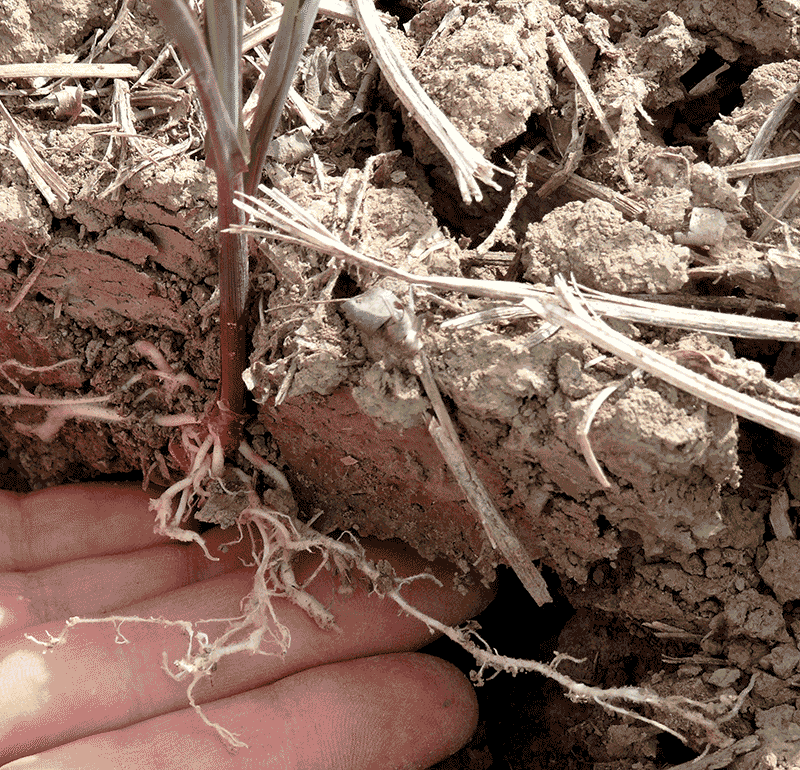Be compaction aware!
A FARMSMART FOCUS

SOIL COMPACTION SEEMS to be a fact of life in most farming operations. We all seem to have it at different extremes at different points in time. While compaction is most often associated with a physical force exerted on or in the soil, there is a complex dynamic relationship between physics, chemistry, and biology that interact to result in different levels of compaction severity.
FIGURE 2: COMPACTION RESULTING FROM COMBINING UNDER SUB OPTIMAL CONDITIONS. (OMAFRA, 2014).

FIGURE 3. ROOT GROWTH IMPACTED BY COMPACTED LAYER AND SEED TRENCH SMEARING. (OMAFRA, 2016).

Compaction results in many negative consequences including poor crop emergence and growth, reduced water infiltration, lower water holding capacity, reduced soil pores lowering gas (oxygen) exchange, oxidation of organic matter, reduced nutrient holding capacity, lower microbial growth, enhanced susceptibility to erosion, surface water pollution, increased production costs, and reduced nutrient cycling among others. The net result is higher production costs and lower revenues (yield) which are the total opposite of what farmers strive to achieve.
Compaction is something that every farmer has experienced at some point. It is difficult to understand compaction because we don’t see it directly; we observe the impact of it. It is also happening at such a microscopic level that even if we could see into the soil we would still struggle to observe the great impacts resulting from it (such as the impact on microbial growth since they are so small we cannot see them).
DETECTION
You can detect compaction in many ways, including observing its impact on crop growth (poor emergence, low vigour, stunted yellow plants — see Figure 1). It can also be observed as deep tracks in the soil after heavy equipment has passed. It can be felt by the resistance detected when a probe is pushed into the soil, or when the tractor response changes when you drag a tillage implement through a compacted area of the field.
There are various severities of compaction. For example, deep compaction caused by driving heavy equipment like manure tankers or loaded combines/grain buggies across the field causes a deeper, more permanent layer of compaction (Figure 2). But compaction also occurs when seeding is conducted under conditions that are too wet, and the planter discs smear the seed trench sides, causing side wall compaction (Figure 3). In both of these situations, the impact on crop growth and yield can be significant. Usually the latter is a single year effect, disappearing either through tillage or frost between the affected and following crop. The earlier example is much harder to remediate.
The two most common physical forces that create compaction are excessive weight and shearing. Weight is simply the total mass of an implement combined with gravity that overwhelms the soils ability to support it. The resulting compression of soils at points below the surface leads to compaction. Shearing happens at whatever depth an implement is operating at and can occur with tillage and planting equipment. In both these examples, the severity or even occurrence of compacted layers is a function of the current dynamics between the physical, chemical, and biological health and conditions of the soil. The interaction of these processes with soil moisture is also important in how and when compaction occurs.
PREVENTION
While it is nearly impossible to avoid compaction, there are technologies and decisions that can be used on the farm to lessen their impact and reduce compaction frequency. Much of this comes down to building healthy soils that, because of soil microbiology, aggregate stability, resilience capacity, and water and air infiltration are better able to offset the negative impacts of poorly timed field operations that in numerous situations are unavoidable. With the increasing size of farms today and the unpredictability of weather, it becomes impossible to be working in our crop fields under optimal conditions. So the management decisions that have to be made involve the selection of the right equipment, flexibility to adjust equipment as conditions dictate, and practicing agronomy that supports soil health including crop rotation, crop complexity, use of cover crops and soil amendments, and appropriate and well-timed field operations.
Once compaction occurs it is more difficult but not impossible to alleviate. However, it is critical to ensure that the compaction busting practices put in place don’t lead to subsequent and worse compaction which is a very distinct possibility.
The 2017 FarmSmart Friday Program – CompactionSmart is a day-long session which will help farmers better understand how and why compaction happens, how to avoid it where possible, and how to deal with it when you have it. This event is bringing together academics, extension specialists, and producers to share their practical knowledge and understanding of this complex problem to help farmers better understand how to deal with it on their farm.
Ian McDonald is the crop innovations specialist with the Ontario Ministry of Agriculture, Food and Rural Affairs. •





















